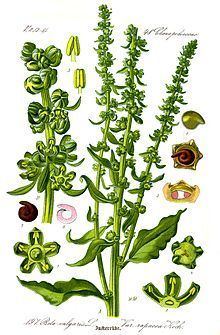Scientific name Beta Rank Genus | ||
 | ||
Lower classifications Common beet, Chard | ||
Beta is a genus in the flowering plant family Amaranthaceae. The best known member is the common beet, Beta vulgaris, but several other species are recognised. Almost all have common names containing the word "beet". Wild Beta species can be found throughout the Atlantic coast of Europe, the Mediterranean coastline, the Near East, and parts of Asia including India.
Contents
Description
This genus consists of annual, biennial, or perennial species, often with fleshy, thickened roots. The stems grow erect or procumbent. The alternate leaves are petiolate or sessile, with ovate-cordate to rhombic-cuneate leaf blades, their margins mostly entire, with obtuse apex.
The inflorescences are long spikelike cymes or glomerules. Bracts can be leaflike (Beta macrorhiza) or very small, the upper half of the inflorescence often without bracts. The bisexual flowers consist of (3-) 5 basally connate perianth segments (either greenish, dorsally ridged and with hooded tips, or petaloid and whitish, yellowish, reddish, or greenish), 5 stamens, and a semi-inferior ovary with 2-3 (-5) stigmas.
The fruit (utricle) is immersed in the swollen, hardened perianth base. The fruit is indehiscent or dehiscence eventually circumscissile. The horizontal seed is orbicular or reniform, with dark brown, smooth or glossy seed coat. The seed contains an annular embryo and copious perisperm.
The base chromosome number is x = 9.
Systematics and distribution
The genus Beta was published in 1753 by Carl Linnaeus. The type specimen is Beta vulgaris L. It is the name-giving genus for subfamily Betoideae in family Amaranthaceae (s.l, including the Chenopodiaceae).
According to phylogenetical research by Kadereit et al. (2006), the genus is classified into 2 sections with 7-8 species:
Excluded species: Beta patellaris Moq., Beta procumbens C.Sm. ex Hornem., and Beta webbiana Moq. are treated as an own genus, Patellifolia A.J.Scott, Ford-Lloyd & J.T.Williams.
Evolution
The differentiation between Beta and Patellifolia probably occurred early in the Late Oligocene. The Mediterranean ancestors of Beta began to differentiate around seven million years ago (Messinian Age of the Late Miocene). They evolved into two well-differentiated clades on each side of the Mediterranean: the western wild beets Beta vulgaris, Beta macrocarpa, and Beta patula, occurring in coastal and ruderal habitats; and the easternmost wild beets Beta corolliflora, Beta nana and Beta trigyna, occurring in continental mountainous zones.
During the Messinian salinity crisis (5.96 to 5.33 million years ago) the Mediterranean Sea partly desiccated and left widespread salt marshes and halophytic habitats. After the sea had flooded back, the marshes were fragmented and taxa became isolated. Subsequent climatic changes led to further diversification. The western wild beets later colonized the Macaronesian Islands during the Pleistocene, probably by adaptations of the diaspores for sea dispersal (thalassochory). On these islands, the diversification was quite recent, and seems to be complicated by events of hybridization and gene flow.
Uses
Beet (Beta vulgaris) has an immense economic importance as sugar crop (Sugar beet), and a great importance as a vegetable (Chard, Beetroot), and as fodder plant (Mangelwurzel). This species is also used as medicinal plant, ornamental plant, dye and as renewable resource. It is the crop species with the highest economical value in the order Caryophyllales. Therefore the members of Beta and the related genus Patellifolia are interesting as Crop wild relatives.
